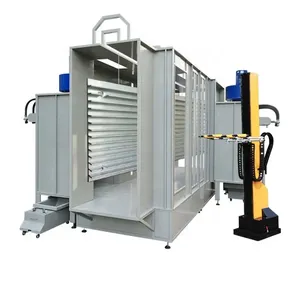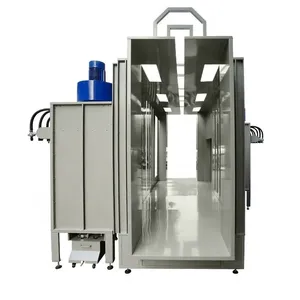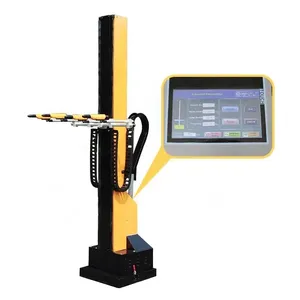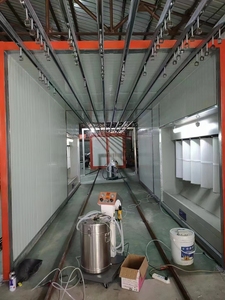
All categories
Featured selections
Trade Assurance
Buyer Central
Help Center
Get the app
Become a supplier

(8638 products available)



























Market Overview: The electrostatic painting line market has demonstrated robust growth, aligning with broader trends in the industrial machinery sector. According to Research and Markets, the global automotive paints and coatings market is estimated to grow from $24.28 billion in 2024 to $39.86 billion by 2030, reflecting a CAGR of 8.59%. This growth is driven by the increasing demand for efficient and environmentally friendly painting technologies. Electrostatic painting lines, known for their ability to reduce overspray and enhance coating uniformity, are becoming a preferred choice among manufacturers. The U.S. market has been pivotal, contributing significantly to this growth, with a particular emphasis on the automotive and industrial sectors, where high-quality finishes are essential.
Industry Insights: The rising focus on sustainability and efficiency has reshaped consumer behavior, pushing manufacturers to adopt advanced painting technologies like electrostatic painting lines. According to IBISWorld, the painting industry has shown resilience, with an aggregate value of $40.2 billion projected for 2023, despite economic fluctuations. The integration of electrostatic technology not only improves operational efficiency but also aligns with the growing emphasis on reducing environmental impact. Leading players in the market are actively innovating, with companies exploring niche applications and enhancing distribution channels to meet the evolving demands of consumers. The competitive landscape is characterized by strategic collaborations and advancements in automation, positioning electrostatic painting lines as a key component in modern manufacturing processes.
An electrostatic painting line is a device/system made for coating workpieces, usually metallic, with powder paint. Production plants often use this device in high-capacity metal surface finishing operations. There are three common types of electrostatic painting lines.
The electrostatic spray painting machine can be used in various industries manufacturing and construction. Here are some of its most common uses:
Furniture Industry
The furniture industry widely uses cataphoresis coating lines. It spreads high-quality paints over various furniture pieces, like tables, cabinets, and chairs. The technology not only enhances the appeal of the furniture but also increases its toughness and longevity by offering resistance to abrasion, moisture, and dirt.
Automobile Manufacturing
Electrostatic spray painting equipment is used largely in the automotive business for painting car bodies and components. It guarantees a uniform coating while reducing paint waste, promoting efficiency in production lines. Not just cars, but other vehicles, such as trucks, motorcycles, and bicycles, also utilize this technology.
Home Appliance Industry
Electrostatic spray painting is widely used in the manufacturing of home appliances. For example, electrostatic painting lines coat refrigerators, air conditioners, washing machines, microwaves, and oven hoods. These devices get a polished finish through electrostatic coating along with resistance to scratches and corrosion.
Metal Product Coating
Various metal products like metal doors, window frames, curtain walls, gates, and more utilize this technology. An electrostatic coating machine applies paints on these products uniformly, resulting in a neat and attractive finish. Additionally, these coatings provide excellent protection against corrosion and wear on the metal surfaces.
Industrial Equipment Coating
Equipment, including generators, pumps, pipes, and valves, is covered in protective coatings using the same technology. After application, these coatings shield the equipment from chemical exposure, wear, and corrosion.
Production Requirement Analysis:
When selecting a line of electrostatic painting for a firm, it's imperative to consider the firm's production requirements. It is vital to consider the production volume, as well as the size and shape of the items being coated. Also, the type of coating material must be factored in, as various coating materials require distinct coating processes and equipment.
Space and Layout Consideration:
While selecting the electrostatic paint line, it's important to consider the available space and layout. The coating line's dimensions and layout should fit into the available space and should also provide a productive and efficient working environment.
Budget and Cost Analysis:
When selecting an electrostatic painting line, it is important to consider the budget and costs. The purchase and installation costs of the coating line should be within the budget. In addition, long-term operational costs, including energy consumption, maintenance costs, and consumables, should also be considered to conduct a cost analysis for the entire life cycle of the coating line.
Quality Control and Assurance:
When selecting an electrostatic painting line, it is essential to emphasize quality control and assurance. During the selection process, it is essential to refer to the quality standards and certification of the coating line, and to ensure that the line of coating meets the required quality standards and is adequately certified.
Q1: What are the advantages of electrostatic painting?
A1: The electrostatic painting process has many benefits, such as a safer and healthier environment, better coverage, fewer rejects, saving production time and costs, improving quality, less paint waste, and lowering overall operating costs.
Q2: Are electrostatic paints more durable?
A2: Electrostatic paints are chemical and weather resistant, allowing them to withstand a wide temperature range without changing their physical properties. They are also flexible, which helps them resist chipping or cracking. This makes electrostatic paints more durable.
Q3: What are the disadvantages of electrostatic painting?
A3: The electrostatic painting process also has some disadvantages, such as the inability to paint large objects, mold and surface preparation, and regular service required to maintain the spraying machine.